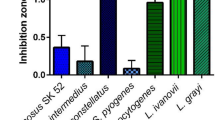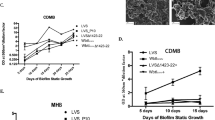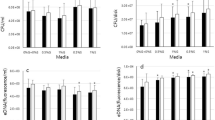Abstract
THE formation of a ‘slime wall’, which is usually a property of Salmonella paratyphi B but not of S. paratyphi B var. java, has long been used as a criterion of differentiation between these two organisms1–4. According to Birch-Hirschfeld5, the slime-wall consists of a nitrogen-free polysaecharide containing more than 40 per cent of glucose. It is formed on solid media, optimally at temperatures of about 20–25° C. and not at 37° C. In this laboratory it is regularly demonstrated by incubating platings on solid media, initially at 37° C. overnight, and afterwards at 21° C. The slime-wall is usually evident after 24 hr. at 21° C. In the search for a reliable medium on which to demonstrate its formation, it was found that the concentration of phosphate exerted a powerful influence on the production of the polysaccharide. The basic solid medium used in these experiments contained 2 per cent of ‘Bacto’ dehydrated nutrient broth (Difco Laboratories), 0.85 per cent sodium chloride and 1.2 per cent New Zealand powdered agar ; it is referred to hereafter as Difco agar. Sörensen buffer, pH. 7.0, was mainly used as the phosphate source. It was added to Difco agar in concentrations of M/5 doubling in dilution to M/I60 (‘phosphate agar’). The favourable effect on slime-wall production was strongest at M/5 and diminished progressively with the fall in phosphate concentration, little effect being observed beyond M/20, which was adopted as the lowest phosphate concentration for routine use. In strains of S. paratyphi B that were slime-wall positive on Difco agar, the amount of slime produced was greatly increased in the presence of phosphate. Strains that formed slime in small amounts or irregularly on nutrient agar produced it in abundance when phosphate was added. Some cultures that were consistently negative on nutrient agar secreted slime on M/5, M/10 and M/20 phosphate agar, others on M/5 and M/10, and yet others on M/5 phosphate agar only.
This is a preview of subscription content, access via your institution
Access options
Subscribe to this journal
Receive 51 print issues and online access
$199.00 per year
only $3.90 per issue
Buy this article
- Purchase on Springer Link
- Instant access to full article PDF
Prices may be subject to local taxes which are calculated during checkout
Similar content being viewed by others
References
Müller, R., Deutsch. med. Wschr., 2, 2387 (1910).
Müller, R., Zbl. Bakt. (Abt. 1, 0), 95, 146 (1925).
Kauffmann, F., Die Bakteriologie der Salmonella-Gruppe, (Munksgaard, Copenhagen, 1944).
Kauffmann, F., Enterobacteriaceae (Munksgaard, Copenhagen, 1954).
Birch-Hirschfeld, L., Z. Hyg. InfektKr., 117, 626 (1935).
Felix, A., and Callow, B. R., Brit. Med. J., ii, 127 (1943).
Felix, A., and Callow, B. R., Lancet, ii, 10 (1951).
Author information
Authors and Affiliations
Rights and permissions
About this article
Cite this article
ANDERSON, E. Slime-wall Formation in the Salmonellae . Nature 190, 284–285 (1961). https://doi.org/10.1038/190284c0
Issue Date:
DOI: https://doi.org/10.1038/190284c0
This article is cited by
-
Slime Polysaccharides of the Enterobacteriaceae
Nature (1963)
Comments
By submitting a comment you agree to abide by our Terms and Community Guidelines. If you find something abusive or that does not comply with our terms or guidelines please flag it as inappropriate.



